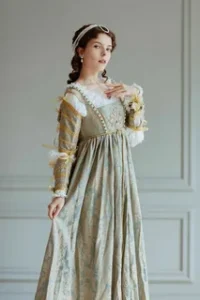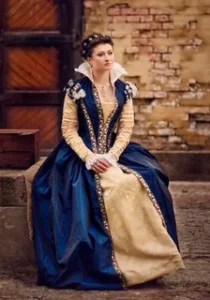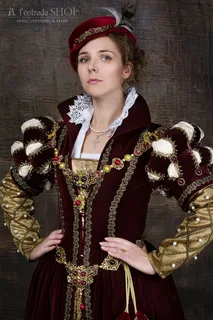Renaissance fashion for women was all about elegance, opulence, and a reflection of social status. As we dive into the world of Renaissance fashion for women, you’ll see how the clothes of that era were more than just fabric and thread—they were statements of power, wealth, and artistic beauty. If you’re intrigued by historical clothing or looking for inspiration from the 14th to 17th centuries, this is the guide for you.
What is Renaissance Fashion?
Renaissance fashion for women dates back to the European Renaissance, a cultural movement that began in Italy in the 14th century and spread across Europe. This period emphasized creativity, innovation, and exploration, and the fashion of the time reflected these themes. Renaissance fashion for women was often characterized by lavish gowns, intricate details, and a wide range of textiles, from silk to velvet.
At the heart of this fashion revolution were vibrant colors, detailed embroidery, and a silhouette that emphasized the ideal female form—long flowing dresses, full skirts, and tight bodices. Renaissance fashion wasn’t just about looking good; it was a way to signal wealth, position, and identity.

Key Features of Renaissance Fashion for Women
Renaissance fashion for women was incredibly detailed, with specific elements that defined the look of the era. Here are some of the most notable features:
- Bodices: The bodice was a central element of Renaissance women’s fashion, designed to fit snugly around the torso. It accentuated the waistline and often featured embroidery, pearls, or metallic thread.
- Full Skirts: Women’s gowns during this period had wide skirts that required petticoats or a farthingale to give them volume. The fuller the skirt, the more prestigious the outfit appeared.
- Sleeves: Sleeves were detachable and often made from contrasting fabrics to the rest of the gown. Sleeves were designed with slashes or puffs to showcase different layers of fabric underneath.
- Necklines: Square or rounded necklines were popular in Renaissance fashion, with some dresses featuring high necklines adorned with ruffles or lace.
- Corsets and Girdles: These undergarments helped to shape the body into the desired form, emphasizing a narrow waist and full hips. The silhouette was structured yet feminine.
- Accessories: Jewelry played a key role in Renaissance fashion, with women often wearing ornate necklaces, belts, and headpieces to complete their look.
Renaissance Fashion for Women: The Fabrics and Colors
When it comes to Renaissance fashion for women, the fabrics were rich and luxurious. Velvet, silk, brocade, and satin were the most coveted materials. Only the wealthy could afford these fabrics, making them symbols of status. Patterns were often embroidered or woven directly into the fabric, using gold or silver thread to create intricate designs.
Colors were also significant. Deep reds, purples, and blues were favored among the nobility, as these colors were expensive to produce. The dyeing process was labor-intensive, making these hues a mark of wealth. In contrast, the middle and lower classes had simpler garments, often made of wool or linen, dyed in muted earth tones.
Renaissance Fashion: Women’s Hairstyles and Headpieces
Hair and headwear were also essential components of Renaissance fashion for women. The elaborate hairstyles of the time were often adorned with veils, jewels, or headdresses such as French hoods or gable hoods. Married women typically wore their hair covered, while unmarried women were allowed to display their tresses.
Hair was often braided or coiled, and wigs were sometimes used to achieve the ideal Renaissance look. Headpieces were commonly jeweled and were another indication of social standing.
The Influence of Renaissance Fashion on Modern Style
While the Renaissance period is long gone, its influence on fashion is still felt today. Corsets, full skirts, and intricate embroidery have made their way back into modern high fashion. Designers like Alexander McQueen and Dolce & Gabbana have incorporated Renaissance-inspired elements into their collections, proving that the allure of this era is timeless.
If you’re looking to bring a touch of Renaissance fashion into your wardrobe, consider pieces with rich fabrics, detailed embroidery, or structured silhouettes. You might not need a full gown, but the inspiration can translate into a statement piece for special occasions.

FAQs About Renaissance Fashion for Women
Q: What were Renaissance dresses made of?
A: Renaissance dresses were typically made from luxurious fabrics like velvet, silk, brocade, and satin. These materials were expensive, making them a symbol of wealth and status.
Q: What was the most popular style of Renaissance dresses?
A: Full skirts and fitted bodices were the hallmark of Renaissance dresses. Sleeves were often detachable, and necklines were square or rounded.
Q: How did Renaissance women style their hair?
A: Renaissance women often braided or coiled their hair and adorned it with jewels, veils, or ornate headpieces. Married women usually covered their hair, while unmarried women let their hair down in loose waves or braids.
Bringing Renaissance Fashion into Today’s Wardrobe
You don’t need a time machine to add a touch of Renaissance elegance to your style. Modern designers frequently take inspiration from Renaissance fashion for women, especially when it comes to opulent fabrics and structured gowns. Here are a few ways you can channel Renaissance fashion in a contemporary way:
- Look for Detailed Embroidery: Embroidered tops or dresses add that luxurious Renaissance feel without going over the top.
- Statement Sleeves: Opt for blouses with puffed or slashed sleeves to give your outfit a historic twist.
- Corset-Inspired Tops: A modern corset top or structured bodice can evoke Renaissance vibes without feeling like a costume.
- Rich Fabrics: Velvet, satin, or brocade pieces instantly elevate your wardrobe and give off that Renaissance opulence.
Conclusion: The Lasting Impact of Renaissance Fashion for Women
Renaissance fashion for women continues to fascinate and inspire, centuries after its inception. With its focus on elegance, luxury, and artistic expression, it left an indelible mark on the fashion world. From the structured bodices to the lavish fabrics, it’s no wonder why this period is frequently referenced in both costume and high fashion.
So, whether you’re looking to add some historical flair to your modern wardrobe or simply fascinated by fashion history, Renaissance fashion for women offers a rich and luxurious world to explore.
Read more: womenfashionwear.site

